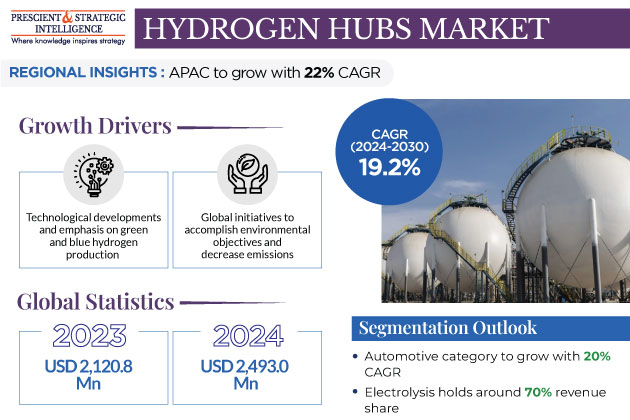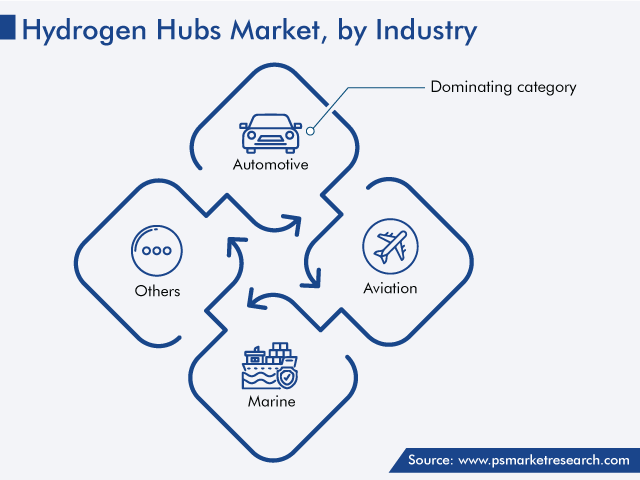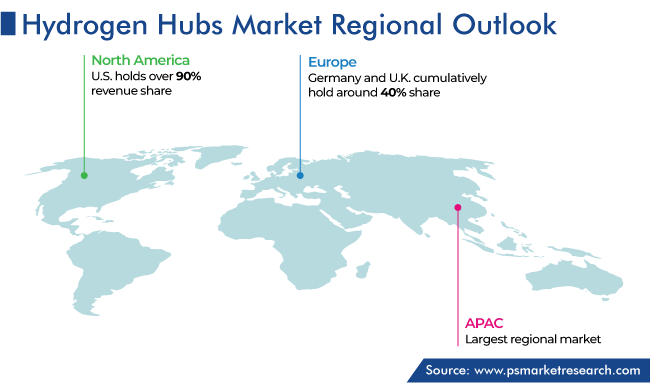Report Code: 12916 | Available Format: PDF | Pages: 280
Hydrogen Hubs Market Size and Share Analysis by Industry (Automotive, Aviation, Marine), Supply Technique (SMR, Electrolysis), End Use (Liquid Hydrogen, Hydrogen Fuel Cell) - Global Industry Revenue Estimation and Demand Forecast to 2030
- Report Code: 12916
- Available Format: PDF
- Pages: 280
- Report Description
- Table of Contents
- Market Segmentation
- Request Free Sample
Hydrogen Hubs Market Overview
The hydrogen hubs market generated revenue of USD 2,120.8 million in 2023, which is expected to witness a CAGR of 19.2% during 2024–2030, reaching USD 7,162.0 million by 2030. The market is principally driven by the global initiatives to accomplish environmental objectives and decrease emissions. Another factor behind the growth is the need for the transform of the transportation and industrial sectors. The government commitments to tackle climate change essentially fuels the demand for hydrogen, which is known for its versatility and low carbon footprint. This has led to significant investments in hydrogen projects and a supportive regulatory framework.

- Technological developments and the parallel emphasis on green and blue hydrogen production enhance the productivity and profitability of hydrogen hub companies.
- The gas supply chain is improved by these facilities, which include distribution, storage, and production systems.
As per the International Renewable Energy Agency (IRENA), Worldwide hydrogen production stood at around 75 Mt per year of pure hydrogen and 45 Mt per year of blends of gases. This is enough to fulfill 3% of the world’s final energy demand and entre Germany’s yearly consumption of energy.
Climate Goals and Emission Regulations Drive Market
Hydrogen is a clean and versatile energy carrier, and it is referred to as "green hydrogen" when it is produced through processes that do not produce carbon dioxide, such as electrolysis powered by renewable energy sources.
- Green hydrogen helps reduce the overall carbon emissions.
- This gas can store the excess amount of energy that is generated from intermittent renewable sources, such as solar and wind.
Many companies are adopting sustainability goals with commitments to lessen their carbon footprint. Green hydrogen is used as a strategic tool by companies to fulfill these targets. Customer choices and corporate strategies are changing due to the growing concern related to climate change and environmental challenges. Consequently, the demand for cleaner and more-sustainable energy solutions is increasing.
- The integration of renewable energy sources into the energy mix contributes to system stability and reliability.
- Hydrogen is perceived as a vital component in accomplishing environmental objectives, which leads to the increase in investments and policy support for hydrogen-related projects.
Many industries, such as shipping, aviation, and heavy manufacturing, face problems with the direct electrification of high-energy processes. Hydrogen delivers a potential solution for decarbonizing these industries, which aligns with climate goals. To increase the deployment of H2 technologies, several governments globally are implementing policies and providing financial incentives. These actions are aimed at achieving climate goals and reducing emissions.
Automotive Category Is Growing with High Rate
Based on industry, the automotive category will have a CAGR of 20% from 2024 to 2030 in the market.
- This is credited to the rising sale of FCEVs fueled by H2.
- The market in this category is also credited to the developments in fuel cell stack technology.
- The production of hydrogen fuel cell vehicles is on the rise due to the investments by major automotive makers in this technology.
- The formation of hydrogen hubs would enable the advancements of the refueling infrastructure, which is an essential step in the widespread adoption of FCEVs.
- The expansion of the market for automobiles powered by hydrogen is aided by the addition of more hydrogen refueling stations within these hubs.
Currently, there is a strong emphasis on decarbonizing the transportation sector. especially heavy vehicles, such as buses and trucks, which increases the demand for hydrogen fuel cells. Partnerships between energy companies, automakers, and other stakeholders in the hydrogen value chain facilitate the establishment of hydrogen hubs, which would contribute in the future growth of the automotive industry.
- Automakers are making efforts to improve the range, efficiency, and durability of FCEVs.
- Globally, several governments are offering incentives, financial support, and funding for hydrogen-related projects, such as the creation of hydrogen hubs and the utilization of vehicles fueled by this gas.
- The expansion of the automobile category is majorly facilitated by the government policies and regulations that support clean transportation.

Electrolysis Category Is Experiencing Significant Growth
Based on supply technique, the electrolysis category is leading the market. This is because of the great focus on lessening carbon emissions and meeting the goals of sustainability, which further raised the demand for green hydrogen created during electrolysis powered by renewable energy. The incorporation of wind and solar power into the hydrogen creation process lines up with the extensive objectives of renewable energy integration.
- Electrolysis is frequently incorporated into hydrogen centers, which act as integrated facilities for the creation, stockpiling, and distribution of this fuel.
- The establishment of hydrogen centers that incorporate electrolyzers is important for an efficient and interconnected hydrogen framework.
- The expanding efforts by both public and private entities in this technique add to the production capacity.
- Large-scale electrolysis facilities are being set up in regions with stiff hydrogen and renewable energy targets.
The advancement, improving efficiency, lower costs, and increasing competitiveness of this process for hydrogen production are the results of ongoing research and development efforts. Moreover, decentralized or distributed electrolysis systems are becoming more popular, in addition to large-scale electrolysis project initiatives. These systems are used for on-site production, to cater to particular local requirements and applications.
Growing Demand for Liquid Hydrogen and Hydrogen Fuel Cells
- The key market driver is the growing demand for liquid H2 and fuel cells that utilize it to create electricity.
- Hydrogen fuel cells are essential for providing backup power to organizations as well as driving a variety of vehicles, including buses, trains, and cars.
- The efficiency and environmental benefits of fuel cells serve as the essential drivers for the usage of hydrogen as a clean energy source.
At the same time, liquid hydrogen is essential for proficient capacity and transportation, particularly for long-distance supply chains and applications in the aerospace sector. The comprehensive approach to harnessing hydrogen's potential across various industries is reflected in the strategic integration of these end products from regional hubs.
| Report Attribute | Details |
Market Size in 2023 |
USD 2,120.8 Million |
Market Size in 2024 |
USD 2,493.0 Million |
Revenue Forecast in 2030 |
USD 7,162.0 Million |
Growth Rate |
19.2% CAGR |
Historical Years |
2017-2023 |
Forecast Years |
2024-2030 |
Report Scope |
Market Trends, Drivers, and Restraints; Revenue Estimation and Forecast; Segmentation Analysis; Impact of COVID-19; Companies’ Strategic Developments; Market Share Analysis of Key Players; Company Profiling |
Segments Covered |
By Industry; By Supply Technique; By End Use; By Region |
Explore more about this report - Request free sample
APAC Is Expected To Grow with High Rate
APAC is expected to witness a CAGR of 22% from 2024 to 2030 in the market.
- The market in the APAC region is driven by the concrete efforts of governments to use sustainable fuels and decrease carbon emissions.
- Governments in the APAC are progressively recognizing hydrogen's role in addressing environmental concerns and accomplishing long-term sustainability targets.
Hence, investments in the region to build comprehensive H2 hubs with a focus on green and blue generation techniques are increasing. APAC is the major participant developing the hydrogen economy, which has been strengthened by the strategic initiatives toward a greener energy. For this, countries are developing a low-carbon and more-sustainable energy sector.

Competitive Analysis
The hydrogen hubs market witnesses strong competition among major energy companies, innovative startups, and technology providers. The major players are Saudi Aramco, Shell plc, Linde Plc, Airbus SE, and Sinopec Group. Organizations that are ahead in innovation, hold significant patents, and have established strong industry connections have the potential for success in the future.
Recent Developments
- Aramco partnered with Aston Martin Formula One Team in December 2023, to become its official title partner.
- Linde signed a long-term agreement in April 2023 to supply green hydrogen to Evonik.
- Shell acquired 100% share of Nature Energy Biogas in February 2023, to make an integrated renewable natural gas (RNG) value chain globally.
- Airbus signed an agreement with HyPort in November 2022 to facilitate the development of a low-carbon hydrogen production center.
- Sinopec and Aramco signed a memorandum of understanding in Dhahran in October 2022 on the YASREF + Project.
Top Providers of Hydrogen Hubs Market Are:
- Saudi Aramco
- Shell plc
- Linde plc
- Airbus SE
- Sinopec Group
- Air Liquide
- Air Products and Chemicals, Inc
- Ballard Power Systems Inc.
- ITM Power PLC
- McPhy Energy S.A.
- Nel ASA
- Plug Power Inc.
- Shell
- Siemens AG Ene
Market Size Breakdown by Segment
This report offers deep insights into the hydrogen hubs market, with size estimation for 2017 to 2030, the major drivers, restraints, trends and opportunities, and competitor analysis.
Based on Industry
- Automotive
- Aviation
- Marine
Based on Supply Technique
- SMR
- Electrolysis
Based on End Use
- Liquid Hydrogen
- Hydrogen Fuel Cell
Geographical Analysis
- North America
- U.S.
- Canada
- Europe
- Germany
- U.K.
- France
- Italy
- Spain
- Asia-Pacific
- Japan
- China
- India
- South Korea
- Australia
- Latin America
- Brazil
- Mexico
- Middle East and Africa
- Saudi Arabia
- South Africa
- U.A.E.
The hydrogen hubs market value will reach USD 7,162.0 million in 2030.
The market for hydrogen hubs will reach USD 2,493.0 million in 2024.
The rising need for liquid H2 & fuel cells that employ it to generate electricity is the key hydrogen hubs industry driver.
Electrolysis hold the larger hydrogen hubs market share.
The APAC market for hydrogen hubs is growing at a high rate.
The hydrogen hubs industry is very competitive, owing to the presence of key energy firms, technology providers, and innovative startups.
Want a report tailored exactly to your business strategy?
Request CustomizationWant an insight-rich discussion with the report author?
Speak to AnalystOur dedication to providing the most-accurate market information has earned us verification by Dun & Bradstreet (D&B). We strive for quality checking of the highest level to enable data-driven decision making for you
Our insights into the minutest levels of the markets, including the latest trends and competitive landscape, give you all the answers you need to take your business to new heights
With 24/7 research support, we ensure that the wheels of your business never stop turning. Don’t let time stand in your way. Get all your queries answered with a simple phone call or email, as and when required
We take a cautious approach to protecting your personal and confidential information. Trust is the strongest bond that connects us and our clients, and trust we build by complying with all international and domestic data protection and privacy laws